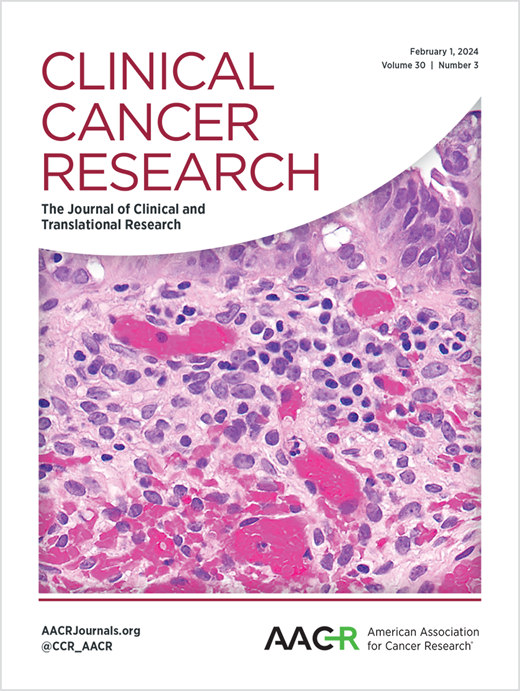T细胞和B细胞反应的空间动态预测可切除和不可切除肝细胞癌的临床结局
IF 10
1区 医学
Q1 ONCOLOGY
引用次数: 0
摘要
目的免疫疗法导致了肝细胞癌(HCC)治疗模式的转变。研究揭示了肿瘤浸润免疫细胞的单细胞目录及其分化轨迹。然而,这些具有不同表型的免疫细胞在肿瘤微环境中的空间分布及其在可切除和不可切除的 HCC 中的临床病理学意义在很大程度上仍不清楚。实验设计我们利用283例手术切除的HCC、联合免疫疗法(阿替佐珠单抗加贝伐单抗[Atezo+Bev])前的58例不可切除HCC样本以及50例晚期HCC的尸检标本,通过多重免疫组化结合转录组学和驱动基因突变分析,分析了瘤内CD4和CD8 T细胞的空间动态及其与B细胞和浆细胞的关联。结果我们发现,干细胞样 CD4 和 CD8 T 细胞主要出现在 T 细胞聚集体中。T滤泡辅助细胞的分化与三级淋巴结构的形成有关,而表型类似T外周辅助细胞的CD4 TCXCL13细胞的分化与淋巴浆细胞微环境的形成有关。细化的免疫亚型可预测手术后可切除的 HCC 和 Atezo+Bev 治疗后不可切除的 HCC 的临床预后。结论 我们揭示了 HCC 中 T 细胞和 B 细胞反应的空间动态,这与手术切除或 Atezo+Bev 治疗后的临床预后密切相关。本文章由计算机程序翻译,如有差异,请以英文原文为准。
Spatial Dynamics of T and B Cell Response Predicts Clinical Outcome of Resectable and Unresectable Hepatocellular Carcinoma.
PURPOSE
Immunotherapies have led to a paradigm shift in the treatment of hepatocellular carcinoma (HCC). Studies have revealed the single-cell catalogues of tumor-infiltrating immune cells and the trajectories of their differentiation. Nevertheless, the spatial distribution of these immune cells with distinct phenotypes in tumor microenvironment and their clinicopathological significance in resectable and unresectable HCCs are still largely unclear.
EXPERIMENTAL DESIGN
We analyzed the spatial dynamics of intratumoral CD4 and CD8 T cells and their association with B and plasma cells using 283 surgically resected HCCs, 58 unresectable HCC samples before combined immunotherapy (atezolizumab plus bevacizumab [Atezo+Bev]), and autopsy specimens from 50 cases of advanced-stage HCCs through multiplex immunohistochemistry combined with transcriptomic and driver gene mutation analysis. Classification based on the spatial dynamics of T and B cell responses (refined immunosubtype) was developed and its clinicopathological significance was analyzed.
RESULTS
We found that stem-like CD4 and CD8 T cells were mainly observed in T cell aggregates. Differentiation of T follicular helper cells were associated with the development of tertiary lymphoid structures, whereas differentiation of CD4 TCXCL13 cells with phenotype resembling T peripheral helper cells were associated with the development of lymphoplasmacytic microenvironment. The refined immunosubtype could predict clinical outcomes of resectable HCC after surgery and unresectable HCC after Atezo+Bev therapy. The immune microenvironment of metastatic lesions tended to reflect those of primary lesions.
CONCLUSIONS
We revealed the spatial dynamics of T and B cell response in HCC, which is closely associated with the clinical outcome after surgical resection or Atezo+Bev therapy.
求助全文
通过发布文献求助,成功后即可免费获取论文全文。
去求助
来源期刊

Clinical Cancer Research
医学-肿瘤学
CiteScore
20.10
自引率
1.70%
发文量
1207
审稿时长
2.1 months
期刊介绍:
Clinical Cancer Research is a journal focusing on groundbreaking research in cancer, specifically in the areas where the laboratory and the clinic intersect. Our primary interest lies in clinical trials that investigate novel treatments, accompanied by research on pharmacology, molecular alterations, and biomarkers that can predict response or resistance to these treatments. Furthermore, we prioritize laboratory and animal studies that explore new drugs and targeted agents with the potential to advance to clinical trials. We also encourage research on targetable mechanisms of cancer development, progression, and metastasis.
 求助内容:
求助内容: 应助结果提醒方式:
应助结果提醒方式:


